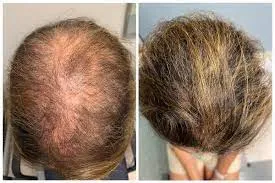There are several medications that have been approved by the FDA (U.S. Food and Drug Administration) for hair growth, as well as other treatments that may be effective in promoting hair growth. Here are a few options:
1. Minoxidil
Minoxidil is a topical medication that is available over-the-counter for the treatment of hair loss. It is applied to the scalp and can help to stimulate hair growth and prevent further hair loss. It may take several months to see results, and it may cause side effects such as scalp irritation or increased hair shedding.
2. Finasteride
Finasteride is an oral medication that is available by prescription for the treatment of male pattern baldness. It works by blocking the conversion of testosterone to dihydrotestosterone (DHT), which can cause hair loss. It may take several months to see results, and it may cause side effects such as decreased sex drive or erectile dysfunction.
3. Corticosteroids
Corticosteroids are medications that can be injected into the scalp to help reduce inflammation and promote hair growth. They are typically used for conditions such as alopecia areata or scarring alopecia.
4. Platelet-rich plasma (PRP) therapy
PRP therapy involves injecting growth factors from the patient's own blood into the scalp to promote hair growth. It may be effective for conditions such as androgenetic alopecia, but more research is needed to confirm its effectiveness.
5. Low-level laser therapy (LLLT)
LLLT involves using a specialized device to deliver low-level laser light to the scalp. It may help to promote hair growth and improve hair thickness, but more research is needed to confirm its effectiveness.
Remember to talk to your dermatologist or healthcare provider before using any new hair growth treatment, especially if you have a history of medical conditions or taking medications. They can help determine the best treatment options for your individual needs and recommend appropriate hair care products to support your hair health.
How long does it take to see results from the therapy?
The results of the therapy for hair loss can vary from person to person, and it may take several months to see noticeable improvements in hair growth. In general, most people start to see results within three to six months after their initial treatment, although some people may see results sooner or later than this.
It's important to note that the therapy is not a cure for hair loss, and additional treatments may be needed to maintain the results. The number of treatments needed can vary depending on the severity of hair loss and the individual's response to the therapy.
The therapy may not be suitable for everyone, and it's important to talk to your dermatologist or healthcare provider to determine whether it is a safe and appropriate option for your specific condition and medical history.
In addition to the therapy, it's also important to practice good hair care habits, such as using gentle shampoos and avoiding excessive heat styling or chemical treatments, to help maintain the health of your hair and promote hair growth.
Risks associated with Hair Growth Treatment
The therapy is generally considered safe, but as with any medical procedure, there are risks and potential side effects to consider. Some of the potential side effects of the therapy for hair loss include:
1. Pain or discomfort
PRP therapy involves injecting a substance into the scalp, which can cause some pain or discomfort during the procedure. Your dermatologist or healthcare provider may use a local anesthetic to help minimize any pain or discomfort.
2. Infection
Any time the skin is broken, there is a risk of infection. Your dermatologist or healthcare provider will take steps to minimize the risk of infection, such as using sterile equipment and following proper infection control procedures.
3. Swelling or bruising
Some people may experience swelling or bruising at the injection site after hair growth therapy. This is usually temporary and should resolve within a few days.
4. Allergic reaction
While rare, some people may have an allergic reaction to the hair growth solution or other components of the therapy.
5. Lack of effectiveness
PRP therapy may not be effective for everyone, and some people may not see significant improvements in hair growth or thickness.
It's important to talk to your dermatologist or healthcare provider about the potential risks and benefits of the therapy for hair loss, and to follow their instructions carefully to minimize the risk of side effects. If you experience any unusual symptoms or side effects after the therapy, be sure to contact your healthcare provider right away.
Lifestyle Changes To Maximize Effectiveness Of Therapy
Making certain lifestyle changes can help to maximize the effectiveness of the therapy for hair loss. Here are a few tips:
1. Eat a healthy diet
Eating a balanced diet that is rich in nutrients such as protein, iron, and vitamins A and C can help to promote hair growth and ensure that your hair is healthy and strong.
2. Exercise regularly
Regular exercise can help to improve circulation and promote hair growth. Aim for at least 30 minutes of moderate exercise most days of the week.
3. Manage stress
Stress can contribute to hair loss, so it's important to manage stress levels through techniques such as meditation, deep breathing, or yoga.
4. Avoid smoking
Smoking can contribute to hair loss and can reduce the effectiveness of the therapy. If you smoke, consider quitting or reducing your tobacco use.
5. Avoid excessive heat styling
Heat styling tools such as flat irons and blow dryers can damage hair and contribute to hair loss. Avoid using these tools excessively, and use a heat protectant spray or serum when you do use them.
Remember to talk to your dermatologist or healthcare provider about any lifestyle changes you are considering, and to follow their instructions carefully to maximize the effectiveness of the therapy for hair loss.



















0 Comments